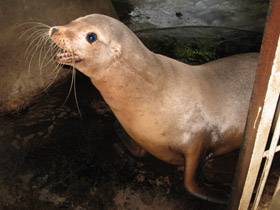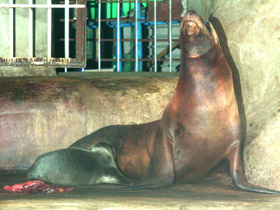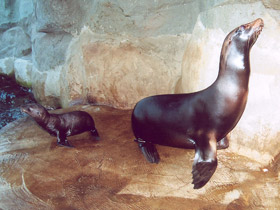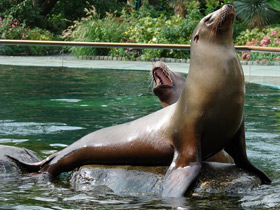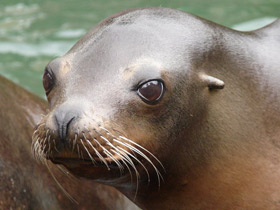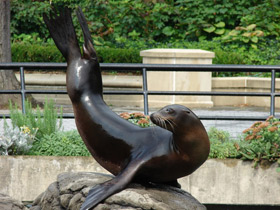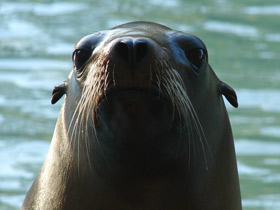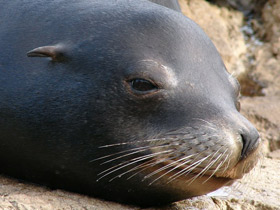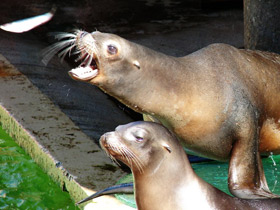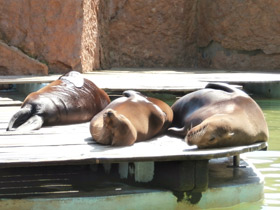The California sea lion (Zalophus californianus)
The California sea lion (Zalophus californianus) is a coastal eared seal native to western North America. It is one of six species of sea lions. Its natural habitat ranges from southeast Alaska to central Mexico, including the Gulf of California. California sea lions are sexually dimorphic; males are larger than females, and have a thicker neck, and a protruding sagittal crest. They mainly haul-out on sandy or rocky beaches, but they also frequent manmade environments such as marinas and wharves. California sea lions feed on a number of species of fish and squid, and are preyed on by orcas and great white sharks.
California sea lions have a polygynous breeding pattern. From May to August, males establish territories and try to attract females with which to mate. Females are free to move in between territories, and are not coerced by males. Mothers nurse their pups in between foraging trips. California sea lions communicate with numerous vocalizations, notably with barks and mother-pup contact calls. Outside their breeding season, California sea lions spend much of their time at sea, but they come to shore to molt.
California sea lions are particularly intelligent, can be trained to perform various tasks and display limited fear of humans if accustomed to them. Because of this, California sea lions are a popular choice for public display in zoos, circuses and oceanariums, and are trained by the United States Navy for certain military operations. The International Union for Conservation of Nature (IUCN) lists the species as Least Concern due to its abundance. To protect fish, the US states of Oregon and Washington engage in annual kill quotas of California sea lions.
Taxonomy
The California sea lion was described by René Primevère Lesson, a French naturalist, in 1828. It is grouped with other sea lions and fur seals in the family Otariidae. Otariids, also known as eared seals, differ from true seals in having external ear flaps, and proportionately larger foreflippers and pectoral muscles. Along with the Galapagos sea lion and the extinct Japanese sea lion, the California sea lion belongs to the genus Zalophus, which derives from the Greek words za, meaning "intensive," and lophus, meaning "crest." This refers to the protruding sagittal crest of the males, which distinguishes members of the genus.
Traditionally, the Galapagos sea lion and Japanese sea lion were classified as subspecies of the California sea lion. However, a genetic study in 2007 found that all three are in fact separate species. The lineages of the California and Japanese sea lion appear to have split off 2.2 million years ago during the Pliocene. The California sea lion differs from the Galapagos sea lion in its greater sexual dimorphism. The Steller sea lion is the closest extant relative of the Zalophus sea lions, being a sister taxon.
Range and habitat
The California sea lion ranges along the western coast and islands of North America, from southeast Alaska to central Mexico. Mitochondrial DNA sequences in 2009 have identified five distinct California sea lion populations: the U.S. or Pacific Temperate stock, the Western Baja California or Pacific Tropical stock, and the Southern, Central, and Northern Gulf of California stocks. The U.S. stock breeds mainly in the Channel Islands, although some breeding sites may be established in northern California, and females are now commonly found there. The Western Baja California stock mainly breeds near Punta Eugenia and at Isla Santa Margarita. The above-mentioned stocks are separated by the Ensenada Front. The stocks of the Gulf of California live in the shallow waters of the north (Northern stock), the tidal islands near the center (Central stock), and the mouth of the bay (Southern stock). The stock status of the California sea lions at the deep waters of the central bay has not been analyzed.
Vagrants can reach the north-western Pacific such as on the Commander Islands. Although several otariinae have been recorded around the Japanese archipelago in recent years, their exact origins are unclear.
During the breeding season, California sea lions gather on both sandy and rocky shores. On warm days, they lie closer to the water. At night or in cool weather, they travel farther inland or to higher elevations. Non-breeding individuals may gather at marinas, wharves, or even navigational buoys. California sea lions can also live in fresh water for periods of time, such as near Bonneville Dam, nearly 150 miles (240 km) up the Columbia River. In 2004, a healthy California sea lion was found sitting on a road in Merced County, California, almost a hundred miles upstream from the San Francisco Bay and half a mile from the San Joaquin River.
Communication
California sea lions communicate with a range of vocalizations. The most commonly used one is their characteristic bark. Territorial males are the loudest and most continuous callers, and barks are produced constantly during the peak of the breeding season. California sea lions bark especially rapidly when excited. The barks of territorial and non-territorial males sound similar, although those of the former are deeper. Males may bark when threatening other males or during courtship. The only other vocalization made by territorial males is a "prolonged hoarse grunt sound" made when an individual is startled by a human. This vocalization is also made by groups of non-reproductive males.
Female California sea lions are less vocal. Their barks, high-pitched and shorter than those made by males, are used in aggressive situations. Other aggressive vocalizations given by females include the "squeal", the "belch", and the "growl". The sound a female California sea lion gives when calling her pups is called a "pup-attraction call", described as "loud" and "brawling". Pups respond with a "mother-response call", which is similar in structure. Pups will also bleat or bark when playing or in distress. California sea lions can produce vocalizations underwater. These include "whinny" sounds, barks, buzzings, and clicks.
Nonbreeding activities
Outside the breeding season, males migrate to the northern ends of the species range to feed, while females forage near the breeding rookeries. California sea lions can stay at sea for as long as two weeks at a time. They make continuous dives, returning to the surface to rest. California sea lions may travel alone or in groups while at sea and haul-out between each sea trip. Adult females and juveniles molt in autumn and winter; adult males molt in January and February. California sea lions in the Gulf of California do not migrate; they stay in the Gulf of California year-round.
Particularities and nutrition
Zalophus californianus is a pinniped mammal of the otariid family.
Zalophus californianus are intelligent and ecologically plastic: they have the ability to adapt to various anthropogenic changes in the environment.
After the breeding period, during which the animals also moult, Zalophus californianus leave the coast and spend the rest of the year at sea. Unlike harbour seals, Zalophus californianus do not migrate long distances and remain 5-20 km offshore during the winter. They feed mainly on cephalopods and fish.
Breeding
Zalophus californianus breeds on land, but usually chooses rocky islands rather than sloping shores. Like other long-eared seals, they are polygamous, and harems form in breeding colonies: 15-20 females usually gather around a male. The harem period lasts 3-4 months, from May to August. Shortly after entering the colony, females give birth to one pup each, and then may become pregnant again. Sea lion pregnancy lasts about a year, but the fertilised egg does not develop for much of that time (the latent phase of pregnancy). The pups are born with eyesight, weigh up to 7 kg and are about 75 cm long, covered with bulky fur and able to move on their own. Mother and calf remain together for about a year, of which she suckles the calf for 6 months. At 2 weeks of age, the young Zalophus californianus begins to learn to swim under the guidance of its mother. Soon the hatchlings form a "playground" where they play together or sunbathe.









